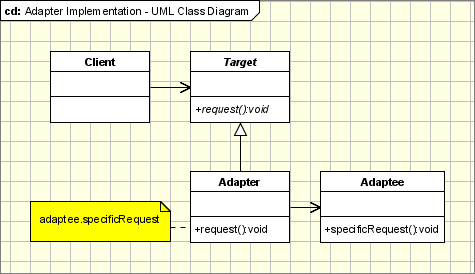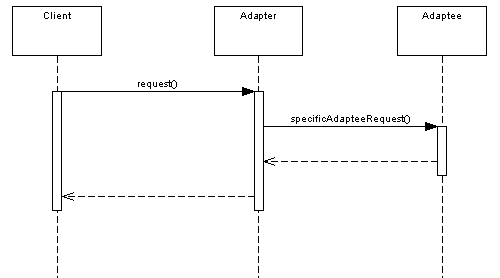Adapter design pattern in Java and Python Development 31.12.2016
Structural Design Patterns provide different ways to create a class structure, for example using inheritance and composition to create a large object from small objects. Following design patterns come under this category.
- Adapter pattern
- Composite pattern
- Proxy pattern
- Facade pattern
- Bridge pattern
- Decorator pattern
- Flyweight pattern
Adapter pattern lets you wrap an otherwise incompatible object in an adapter to make it compatible with another class.
Adapter pattern works as a bridge between two incompatible interfaces. Sometimes, there could be a scenario when two objects don’t fit together, as they should in-order to get the work done. This situation could arise when we are trying to integrate a legacy code with a new code, or when changing a 3rd party API in the code. This is due to incompatible interfaces of the two objects which do not fit together. In this case we can use Adapter design pattern.
As a real life example, we can think of a mobile charger as an adapter because mobile battery needs 3 volts to charge but the normal socket produces either 120V (US) or 240V (India). So the mobile charger works as an adapter between mobile charging socket and the wall socket.
Adapter design pattern is used so that two unrelated interfaces can work together. The object that joins these unrelated interfaces is called an Adapter. In the adapter pattern, a wrapper class (i.e., the adapter) is used translate requests from it to another class (i.e., the adoptee). In effect, an adapter provides particular interactions with an adoptee that are not offered directly by the adoptee.
UML diagram of generic adapter design pattern:
Elements:
- Target defines domains-specific interface client uses.
- Client collaborates with objects conforming to target interface.
- Adaptee defines existing interface that needs adapting.
- Adapter adapts the interface of adaptee to target interface.
The Adapter pattern should be used when:
- There is an existing class, and its interface does not match the one you need.
- You want to create a reusable class that cooperates with unrelated or unforeseen classes, that is, classes that don’t necessarily have compatible interfaces.
- There are several existing subclasses to be use, but it’s impractical to adapt their interface by subclassing every one. An object adapter can adapt the interface of its parent class.
Let's take a look at the interactions in a sequence diagram.
Java
So first of all we will have two classes – Volt (to measure volts) and Socket (producing constant volts of 120V).
public class Volt {
private int volts;
public Volt(int v) { this.volts=v; }
public int getVolts() { return volts; }
public void setVolts(int volts) { this.volts = volts; }
}
public class Socket {
public Volt getVolt(){ return new Volt(120); }
}
Now we want to build an adapter that can produce 3 volts, 12 volts and default 120 volts. So first of all we will create an adapter interface with these methods.
public interface SocketAdapter {
public Volt get120Volt();
public Volt get12Volt();
public Volt get3Volt();
}
While implementing Adapter pattern, there are two approaches – class adapter and object adapter – however both these approaches produce same result.
- Class Adapter. This form uses java inheritance and extends the source interface, in our case
Socketclass. - Object Adapter. This form uses java composition and adapter contains the source object.
Here is the class adapter approach implementation of our adapter.
// using inheritance for adapter pattern
public class SocketClassAdapterImpl extends Socket implements SocketAdapter {
@Override
public Volt get120Volt() {
return getVolt();
}
@Override
public Volt get12Volt() {
Volt v = getVolt();
return convertVolt(v,10);
}
@Override
public Volt get3Volt() {
Volt v = getVolt();
return convertVolt(v,40);
}
private Volt convertVolt(Volt v, int i) {
return new Volt(v.getVolts()/i);
}
}
Here is the object adapter implementation of our adapter.
public class SocketObjectAdapterImpl implements SocketAdapter {
// using composition for adapter pattern
private Socket sock = new Socket();
@Override
public Volt get120Volt() {
return sock.getVolt();
}
@Override
public Volt get12Volt() {
Volt v = sock.getVolt();
return convertVolt(v,10);
}
@Override
public Volt get3Volt() {
Volt v = sock.getVolt();
return convertVolt(v,40);
}
private Volt convertVolt(Volt v, int i) {
return new Volt(v.getVolts()/i);
}
}
Here is a test program to consume our adapter design pattern implementation.
public class AdapterPatternTest {
public static void main(String[] args) {
testClassAdapter();
testObjectAdapter();
}
private static void testObjectAdapter() {
SocketAdapter sockAdapter = new SocketObjectAdapterImpl();
Volt v3 = getVolt(sockAdapter,3);
Volt v12 = getVolt(sockAdapter,12);
Volt v120 = getVolt(sockAdapter,120);
System.out.println("v3 volts using Object Adapter="+v3.getVolts());
System.out.println("v12 volts using Object Adapter="+v12.getVolts());
System.out.println("v120 volts using Object Adapter="+v120.getVolts());
}
private static void testClassAdapter() {
SocketAdapter sockAdapter = new SocketClassAdapterImpl();
Volt v3 = getVolt(sockAdapter,3);
Volt v12 = getVolt(sockAdapter,12);
Volt v120 = getVolt(sockAdapter,120);
System.out.println("v3 volts using Class Adapter="+v3.getVolts());
System.out.println("v12 volts using Class Adapter="+v12.getVolts());
System.out.println("v120 volts using Class Adapter="+v120.getVolts());
}
private static Volt getVolt(SocketAdapter sockAdapter, int i) {
switch (i){
case 3: return sockAdapter.get3Volt();
case 12: return sockAdapter.get12Volt();
case 120: return sockAdapter.get120Volt();
default: return sockAdapter.get120Volt();
}
}
}
Python
class Volt:
def __init__(self, volt):
self.volt = volt
def get_volt(self):
return self.volt
def set_volt(self):
self.volt = volt
class Socket:
def get_volt(self):
return Volt(120)
class SocketClassAdapterImpl(Socket):
def get_120volt(self):
return self.get_volt()
def get_12volt(self):
v = self.get_volt()
return self.convert_volt(v, 10)
def get_3volt(self):
v = self.get_volt()
return self.convert_volt(v, 40)
def convert_volt(self, v, i):
return Volt(v.get_volt() / i)
def get_volt(sock_adapter, i):
if i == 3:
return sock_adapter.get_3volt()
elif i == 12:
return sock_adapter.get_12volt()
elif i == 120:
return sock_adapter.get_120volt()
return sock_adapter.get_120volt()
if __name__ == '__main__':
sock_adapter = SocketClassAdapterImpl()
v3 = get_volt(sock_adapter, 3)
v12 = get_volt(sock_adapter, 12)
v120 = get_volt(sock_adapter, 120)
print("v3 volts using Class Adapter=" + str(v3.get_volt()))
print("v12 volts using Class Adapter=" + str(v12.get_volt()))
print("v120 volts using Class Adapter=" + str(v120.get_volt()))
Quote
Categories
- Android
- AngularJS
- Databases
- Development
- Django
- iOS
- Java
- JavaScript
- LaTex
- Linux
- Meteor JS
- Python
- Science
Archive ↓
- September 2024
- December 2023
- November 2023
- October 2023
- March 2022
- February 2022
- January 2022
- July 2021
- June 2021
- May 2021
- April 2021
- August 2020
- July 2020
- May 2020
- April 2020
- March 2020
- February 2020
- January 2020
- December 2019
- November 2019
- October 2019
- September 2019
- August 2019
- July 2019
- February 2019
- January 2019
- December 2018
- November 2018
- August 2018
- July 2018
- June 2018
- May 2018
- April 2018
- March 2018
- February 2018
- January 2018
- December 2017
- November 2017
- October 2017
- September 2017
- August 2017
- July 2017
- June 2017
- May 2017
- April 2017
- March 2017
- February 2017
- January 2017
- December 2016
- November 2016
- October 2016
- September 2016
- August 2016
- July 2016
- June 2016
- May 2016
- April 2016
- March 2016
- February 2016
- January 2016
- December 2015
- November 2015
- October 2015
- September 2015
- August 2015
- July 2015
- June 2015
- February 2015
- January 2015
- December 2014
- November 2014
- October 2014
- September 2014
- August 2014
- July 2014
- June 2014
- May 2014
- April 2014
- March 2014
- February 2014
- January 2014
- December 2013
- November 2013
- October 2013

